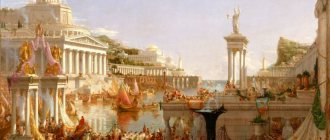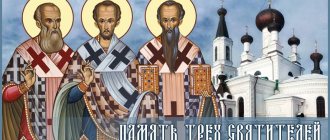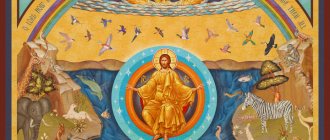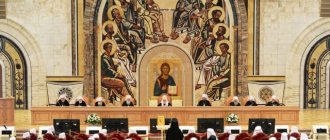The theory “Moscow is the Third Rome;” was put forward in the 16th century under Grand Duke Vasily III. Its author was Philotheus, the elder of the Eleazar Monastery in the city of Pskov. The essence of the concept is that the heir to the Roman Empire and Byzantium is Russia - as a stronghold of Orthodoxy. The theory's appearance is briefly studied in the school history course in grades 7 and 10.
Emergence of the concept
As the Grand Duchy of Moscow rose in the 14th–15th centuries, it began to develop ideas about its messianic purpose.
Rice. 1. Moscow - Third Rome.
A number of events contributed to this:
- Establishment of autocephaly of the Moscow Metropolitanate since 1448. Rejection of the Union of Florence of 1439 between Rome and Constantinople.
- The end of the period of the Horde yoke. The collapse of the former formidable enemy, the Golden Horde, into several khanates.
- The unification of Russian principalities and lands around Moscow by the 1520s.
- Expanding ties with Catholic Europe.
- The marriage of Ivan III with Sophia Palaeologus, the niece of the last emperor of Byzantium, Constantine XI.
Elder Philotheus lived in the Eleazar Monastery of Pskov. He was born around 1465 and wrote two epistles in 1523–1524. The first - to clerk Mikhail Munekhin, and the second - to Grand Duke Vasily III. The idea was formulated in the spirit of “two Romes fell due to their sins, a third stands, but a fourth will not exist.”
Philotheus put Basil III on a par with Emperor Constantine the Great, who ruled in the first third of the 4th century AD. e. He became famous for introducing Christianity as the main religion in the Roman Empire and moving the capital to the new Rome - Constantinople.
Rice. 2. Moscow - Third Rome. Filofey.
Why is Moscow called the third Rome?
Coat of arms of the Holy Roman Empire
In order to understand why Moscow is the third Rome, it is necessary to remember the first two. The Roman Empire, which gave the world classical law, architecture and the art of war, was a formidable adversary until the 5th century. Rome was considered a stronghold of culture and education. In 313, Christianity became the official religion of the Romans, which put an end to religious strife. A hundred years later the Roman Empire was defeated. In 455, after a long siege, Rome was sacked and destroyed.
In the 5th century, a new great empire appeared on the world stage - the Byzantine Empire. It was she who “sheltered” Orthodox Christianity. Byzantium did not simply adopt the spiritual values of Rome. The new empire also inherits history, scientific achievements, and culture. Constantinople became the world center of Orthodox Christianity, the Byzantine patriarchs were considered the most revered. The Second Rome existed for a thousand years, and in 1453 Byzantium fell under the onslaught of Turkish-Ottoman troops.
Bird's eye view of Constantinople in the Byzantine era (reconstruction)
Related events of the 16th century
At the beginning of the 16th century, a legend appeared about the Byzantine origin of the Monomakh cap and other grand ducal, and then royal regalia. Allegedly, it was sent to Prince Vladimir by the Byzantine Emperor Constantine Monomakh, hence the nickname.
The idea of a “Third Rome” was developed in Russian literature of the 16th century. It is mentioned in “The Tale of the White Cowl”, where it refers to Novgorod the Great. The hood itself comes from Pope Sylvester, his in the first third of the 4th century AD. e. presented by Emperor Constantine.
This phrase is mentioned in “Kazan History” - a historical story of the 1560s about the campaign of Ivan IV to Kazan. In the declaration of the 1589 proclamation of the Moscow Patriarchate as the “Third Rome,” they mean not Moscow, but the Russian kingdom.
The idea of a special purpose for Moscow and Russia was strengthened in the 16th century under the influence of religious wars in Europe with the appearance of the legend about the ancestry of Prince Rurik from Prus, the brother of the Roman Emperor Augustus.
Ivan IV the Terrible became the heir of Vasily III. He was crowned king in 1547, having received a written blessing from the patriarch in Constantinople.
Mention of the “Third Rome” can be found in the “Tale of the Beginning of Moscow” of the 17th century and in the petitions that Old Believers sent to the Russian emperors in the 18th century.
Rice. 3. Vasily III.
Relevance of the idea
Many Russians perceived the discovery of the grave of the Pskov elder Philotheus, a preacher of the main Russian idea, as a sign testifying to our national revival. And we need to treat him very responsibly, remembering today this wonderful personality and the meaning of the words spoken by the elder.
Today a lot is said about Filofey’s theory “Moscow – the Third Rome”. You can hear about it both from supporters of the political and spiritual strengthening of our country, and from its opponents. But are they all able to explain the meaning of these words and their origin? Indeed, in this case we are talking about an idea that lies at the basis of the self-awareness of Moscow Rus', which is of a religious and political nature. It has retained its fundamental role to this day.
Religious and political foundations
To understand Philotheus’s theory, you need to familiarize yourself with the fundamentals of the religious and political history of Christian civilization, which he himself reminds of. These foundations go back to the biblical stories of the prophet Daniel. The latter, interpreting the dream of King Nebuchadnezzar of Babylon, predicts the existence of four kingdoms that succeed each other in time. The very last of them will be destroyed by the Lord God himself.
Hippolytus of Rome, who was the father of the 2nd century church, spoke of the Babylonian, Persian, Macedonian and, finally, the Roman kingdom. It is important to note that these kingdoms were not simple national monarchies, but were the only empires that, during the period of their existence, claimed to be the expression of the entire world civilization, the entire world order as such.
The Romans, who professed paganism, like the Christian Romans, believed that Rome would always stand, that is, until the end of time. And the reason for this is not the strength of the Romans themselves, but the fact that the Roman order is a world order that resists world chaos. In the so-called eternal city, many Christians saw a mystical power relating to the end of times. It keeps the Antichrist from coming. The Apostle Paul spoke about this power in 2 Thessalonians.
When Rome adopted Christianity as the state religion in the 4th century, the idea of Rome as “katechon,” which in Greek means “holding,” began to be expressed directly by theologians, as, for example, by St. John Chrysostom.
European claims to the Third Rome
But such a monumental building cannot be erected due to someone’s arbitrariness. It must have a solid base, and it is necessary to take into account factors such as external and internal resistance. This is precisely what was well understood by Elder Philotheus.
It should be noted that at that time many countries in Europe were trying to build something like the Third Rome. They calculated the pedigrees of their monarchs and came up with artificial succession. This can be clearly seen in the heraldry of many small principalities and cities, which has an aggressively pompous character.
But, according to researchers, it was the Moscow principality that had the prerequisites to call itself the Third Rome. However, this did not happen for a long time; it took almost 100 years for this fact to be publicly recognized.
Modesty mentality
Why did this happen? There are many different versions offered as an answer to this question. One of them, lying on the surface, is the unprecedented modesty that characterizes the Russian, East Slavic mentality. This can be clearly seen in the development of the culture of monasticism in Medieval Rus'.
However, such modesty can sometimes turn into false self-deprecation. Then, having all the rights, as well as the opportunity to claim their advantages, the Russians leave it to others. So the elder himself characterized himself as a rural man who studied letters, understood nothing of Hellenic wisdom, did not talk with intelligent philosophers, but only studied the gracious Law in order to cleanse his soul from sin.
Meanwhile, Philotheus’s ideas and the texts of his messages testify to European learning and mastery of rhetorical science. Otherwise, representatives of the educated elite at the Moscow court would never have listened to him, would not have asked him for advice, and would simply not have known anything about him.
"Message to the Stargazers"
Beginning in 1484, Nikolai Bulev, a physician and astrologer, envoy of the Pope, began to actively promote his ideas in the Russian state. He became the personal physician of Vasily III, the Grand Duke. He was opposed by great authorities, including Saint Maximus the Greek, but despite this, his influence did not decrease.
To understand the astrological teachings of Bulev, Mikhail Grigorievich, a grand-ducal deacon with the surname Misyur-Munekhin, turned to Elder Philotheus, which is evidence of the latter’s authority for the Moscow court. At the turn of 1523-1524. he writes a letter to the deacon of the Grand Duke, which has become famous, entitled “Message to the Astrologers.”
In it, the Orthodox monk expresses his categorical rejection of astrology, viewing it as a heretical, false teaching. It also explains the basics of the Christian worldview, which prohibit attributing good and evil to astronomical phenomena, otherwise a person is not responsible for his own will, and the meaning of the Last Judgment disappears.
Thus, Philotheus continues the polemics of such authorities as St. Gennady, Joseph of Polotsk and Maxim the Greek, which had an anti-occult orientation. It is important to emphasize that the beginning of the presentation of the theory of “Moscow - the Third Rome” was laid in the midst of dogmatic polemics directed against the false teachings of paganism.
Philotheus, denouncing both faith in astrology and other troubles of that time, reminds the deacon, and through him the Grand Duke, of the unique historical situation that has developed in Rus'. And also about what mission is entrusted to her, and why it is very important at this moment not to deviate from the Orthodox faith, but to adhere to it more than ever.
Anti-Christian tendencies
The advent of the Renaissance in Europe brought with it not only positive trends, but also anti-Christian and neo-pagan ones. A series of essentially occult movements arose, of which quite a large number were observed. Some of them actively penetrated into Russia. As a rule, this happened through Novgorod and the Baltic lands.
Today little is said about this, but then there was a possibility of the victory of such syncretic movements in our country, because even the great princes themselves favored them. Some of the church hierarchs were also tempted by these heresies. To overcome them, it took the efforts of prominent figures of the Russian Church. Among them we can note St. Archbishop Gennady of Novgorod and St. Joseph of Volotsk.





